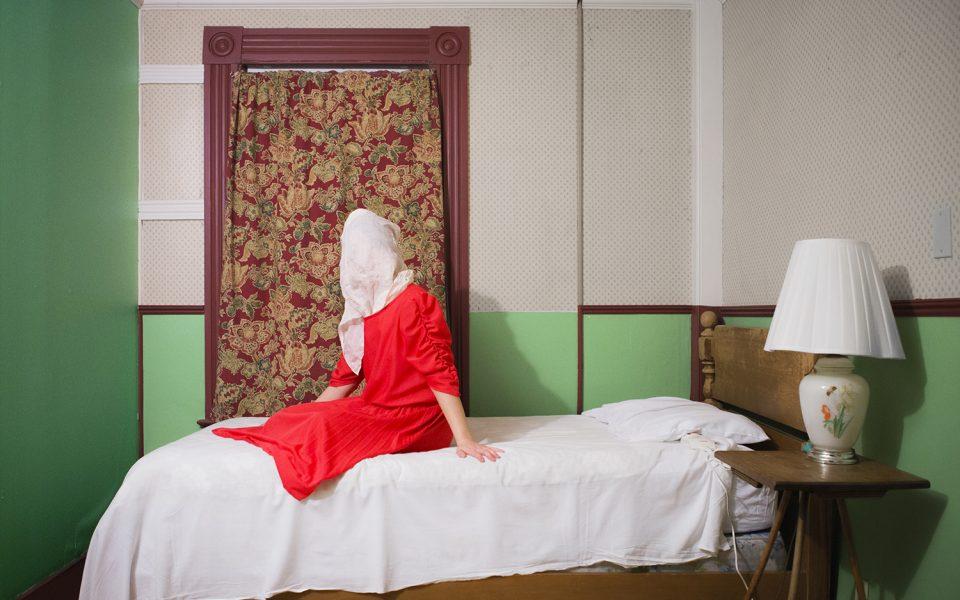The scene of a woman sitting on a bed in a room with shallow background, her hand rested lightly on the mattress, feels like any Romantic painter’s rendition of a seated portrait. Except for one small detail: The woman is wearing a linen bag over her head.
The photograph — Mijoo Kim’s 2014 piece called “Red Dress” — is part of her current exhibit at the Southeastern Center for Contemporary Art in Winston-Salem. It stirs an uneasy longing mixed with menacing implications, touching on feminine identity and the power of clothing in shaping that identity.
Kim is showing from two of her recent fine-art series, Role-Play and Re-Figure. The former uses posed fabric set against surreal backdrops or the North Carolinian outdoors to juxtapose themes of belonging and being lost. In Re-Figure, peppy prints are paired with the ominous anonymity of the artist’s presence.
Kim is one of 12 artists in the 12×12 artist salon series at SECCA, which presents a dozen artists from North Carolina, the nation’s 12th state. Curator Cora Fisher worked with a team of guest curators to pick the participants for the series, which runs through the spring of 2017. Each month’s artist opens with a casual salon talk, culminating in a final collaborative show with pieces from all artists involved.
Kim’s surreal approach can seem sterile upon first glance, but there’s some not-so-hidden, menacing subtext under the familiar backdrops, such as in “Polka Dot Dress,” set at a fairy tale-esque wooded babbling brook and featuring a rumpled dress abandoned in the foreground, hinting at some dark event that may have taken place just before the photographer arrived.
Visitors are encouraged to think of the series as pop-up mini exhibits, which makes sense seeing as SECCA’s Preview Gallery space is rather limited compared to the expansive architecture of the rest of the museum. It’s essentially a small and low-ceilinged extension of the atrium, which permits a less solemn vibe to take over the room.
That complements Kim’s brightly colored photographs on themes of identity, migration and belonging — though she didn’t always focus on fine-art photography. Before earning her MFA from UNC Chapel Hill in 2015, Kim studied photography in her native South Korea and then earned another bachelor’s degree from the School of the Art Institute of Chicago.
“Before moving to North Carolina, I was interested in documentary style,” Kim said in an interview.
Growing up in South Korea, Kim’s father ran his own business, and employed immigrants from other Asian countries. The beginning of her interest in photography intersected with her interest in the workers’ stories, she said.
“At that time I [was] interested in understanding and representing people’s lives in various societies,” she said.
She remembered first beginning to try her hand at photography 10 years ago, using her grandfather’s Canon, and pursuing street photography. Her street savvy served her well when she moved to Chicago and encountered sharp sensations of displacement and estrangement.
“At first, it’s really hard,” Kim said. “I was still learning English. I dragged around a camera to talk to other people with a camera and a tripod.”
In that way, photography was her second language.
“That’s why I was a street photographer,” she said.
“Taking photos, it’s another language to connect.”
Kim shared a story of crossed cultural wires that took place with her friend while studying at the School of the Art Institute of Chicago. The two of them went on a photo field trip, driving to Northern Illinois in search of stories. They picked a house at random and walked right up to the front porch.
“I didn’t know [this] was weird,” Kim said.
No harm done. Turns out the man who answered the door was a ham radio enthusiast who, upon being solicited for stories, took the pair down into his basement to show all of his radio equipment.
“He was such a great guy,” she said.
Serendipitous moments like this are the reason Kim enjoys her medium, adding that she has the ability to represent different pieces of a cultural tapestry in her work.
Today, she isn’t in any strangers’ basements. She’s in Long Island City for her second artist residency in New York state, the first having been in 2014 at the Center for Photography at Woodstock, and now with the plainly named Artist Residency Program New Work.
At Woodstock, one of the best things about her time there was the assistance she received from fellow resident artists and director Ariel Shanberg in conceptualizing the Re-Figure series.
Another small perk of the Woodstock residency?
“They pay for everything,” Kim said with a small laugh.
Spoken like a true artist.
Mijoo Kim’s 12×12 pop-up exhibit runs at SECCA’s Preview Gallery in Winston-Salem through May 15.
Join the First Amendment Society, a membership that goes directly to funding TCB‘s newsroom.
We believe that reporting can save the world.
The TCB First Amendment Society recognizes the vital role of a free, unfettered press with a bundling of local experiences designed to build community, and unique engagements with our newsroom that will help you understand, and shape, local journalism’s critical role in uplifting the people in our cities.
All revenue goes directly into the newsroom as reporters’ salaries and freelance commissions.


Leave a Reply